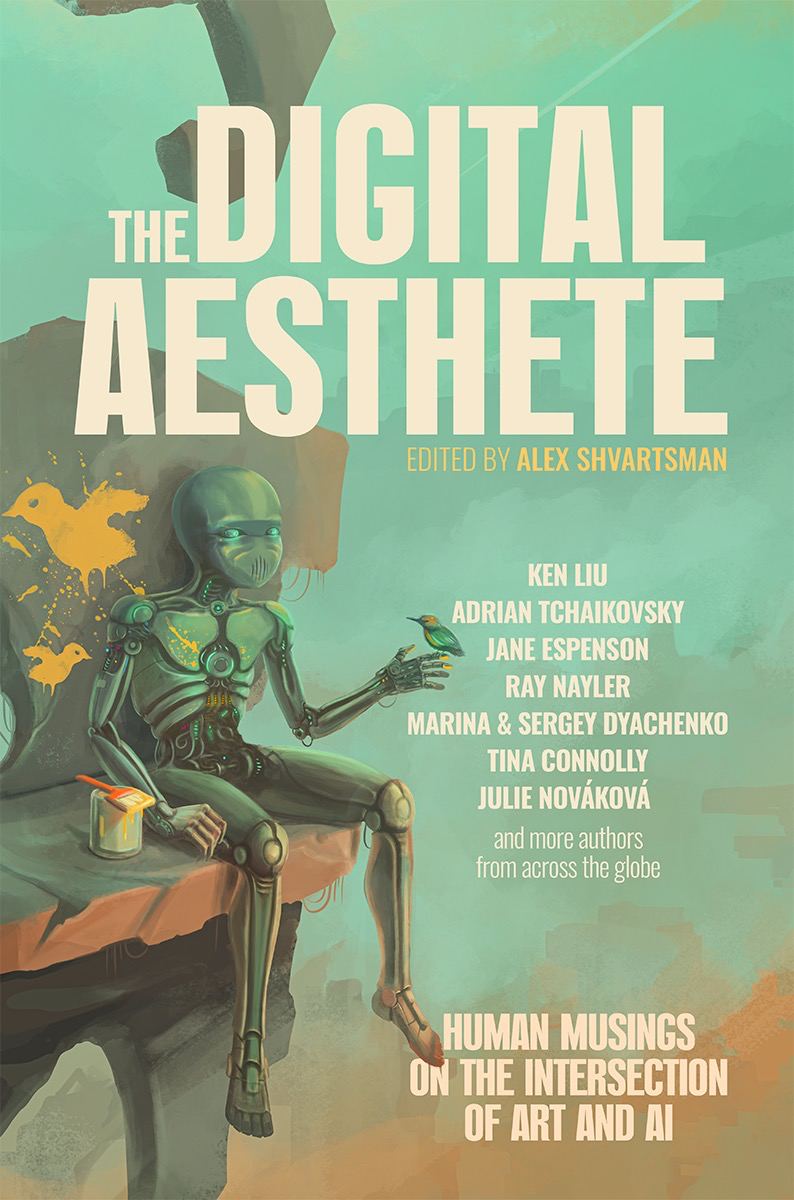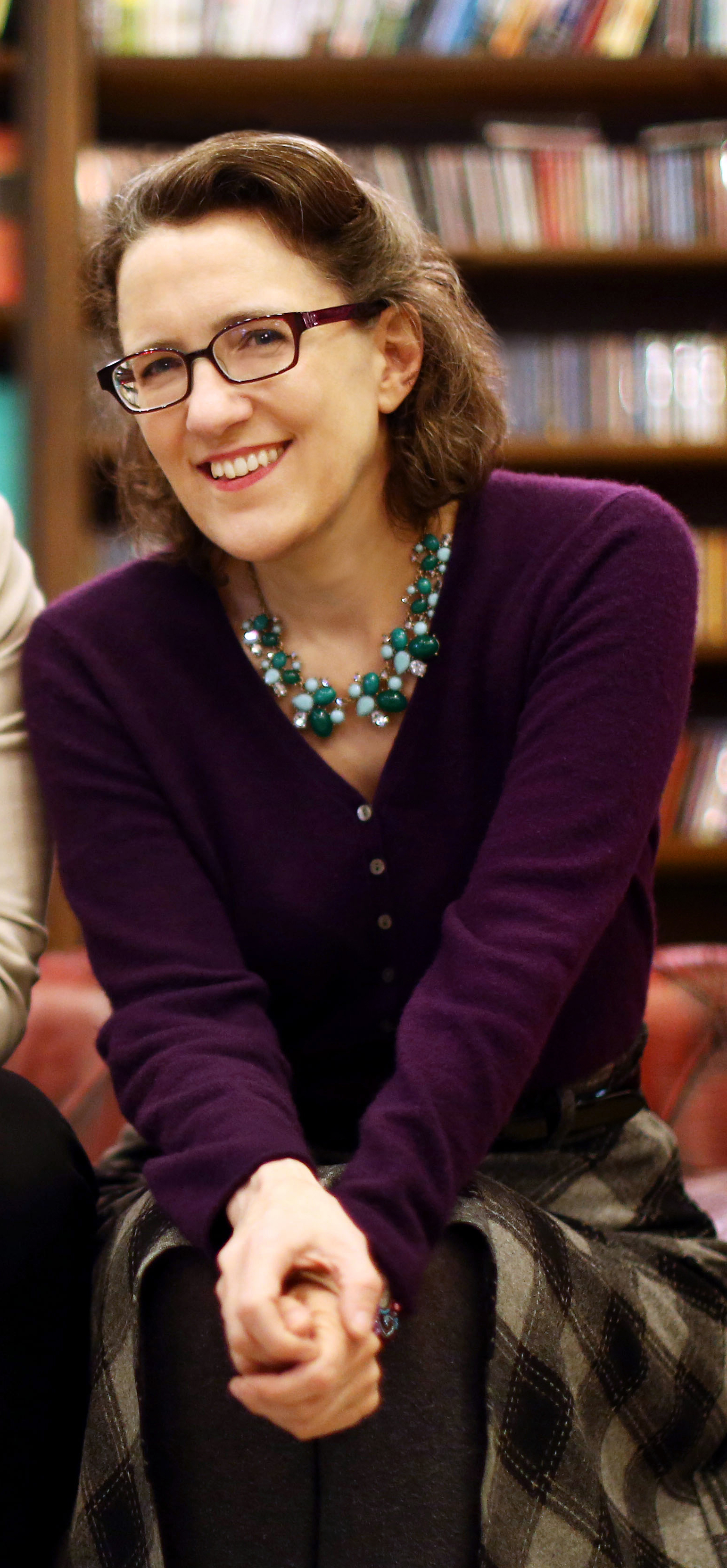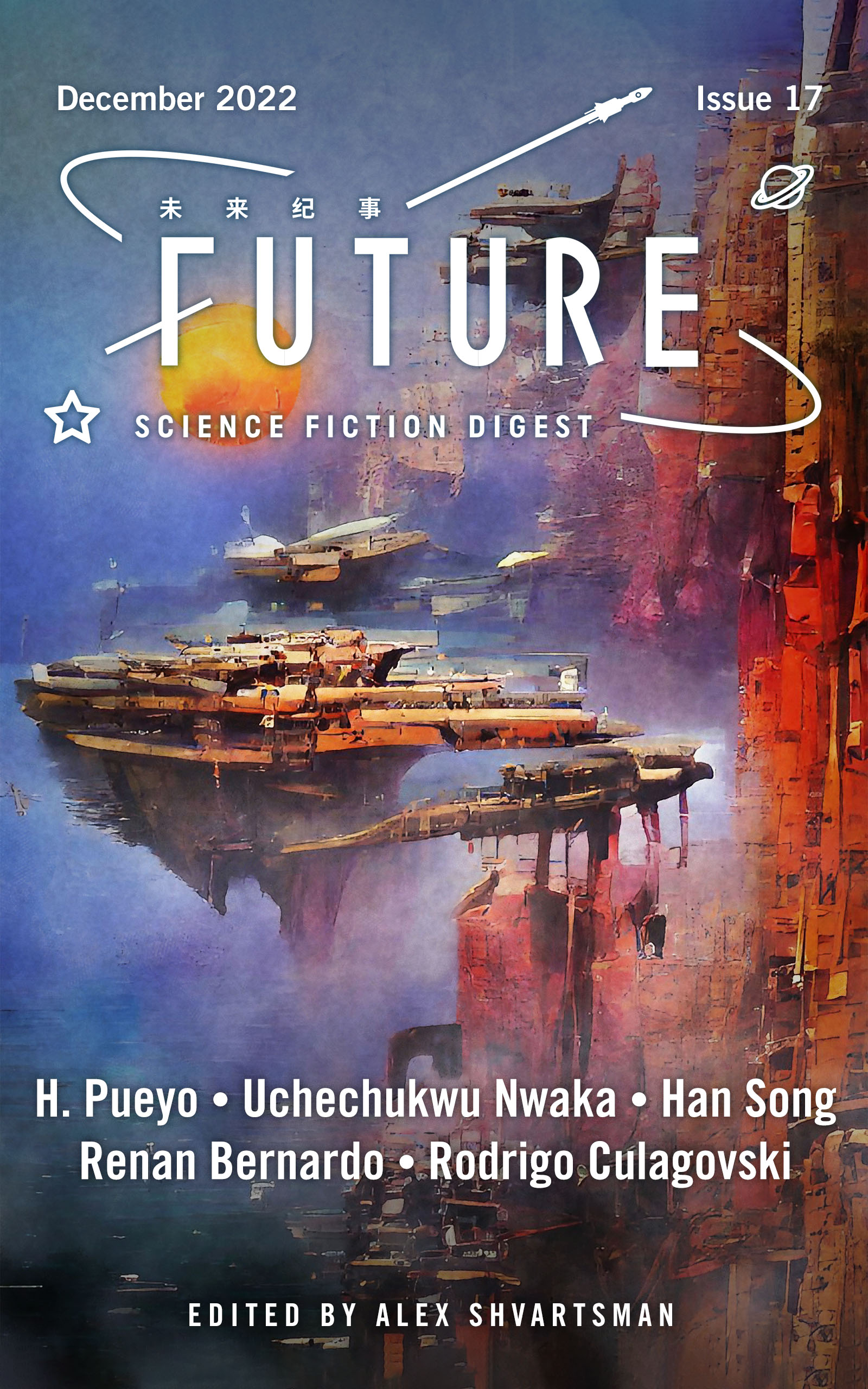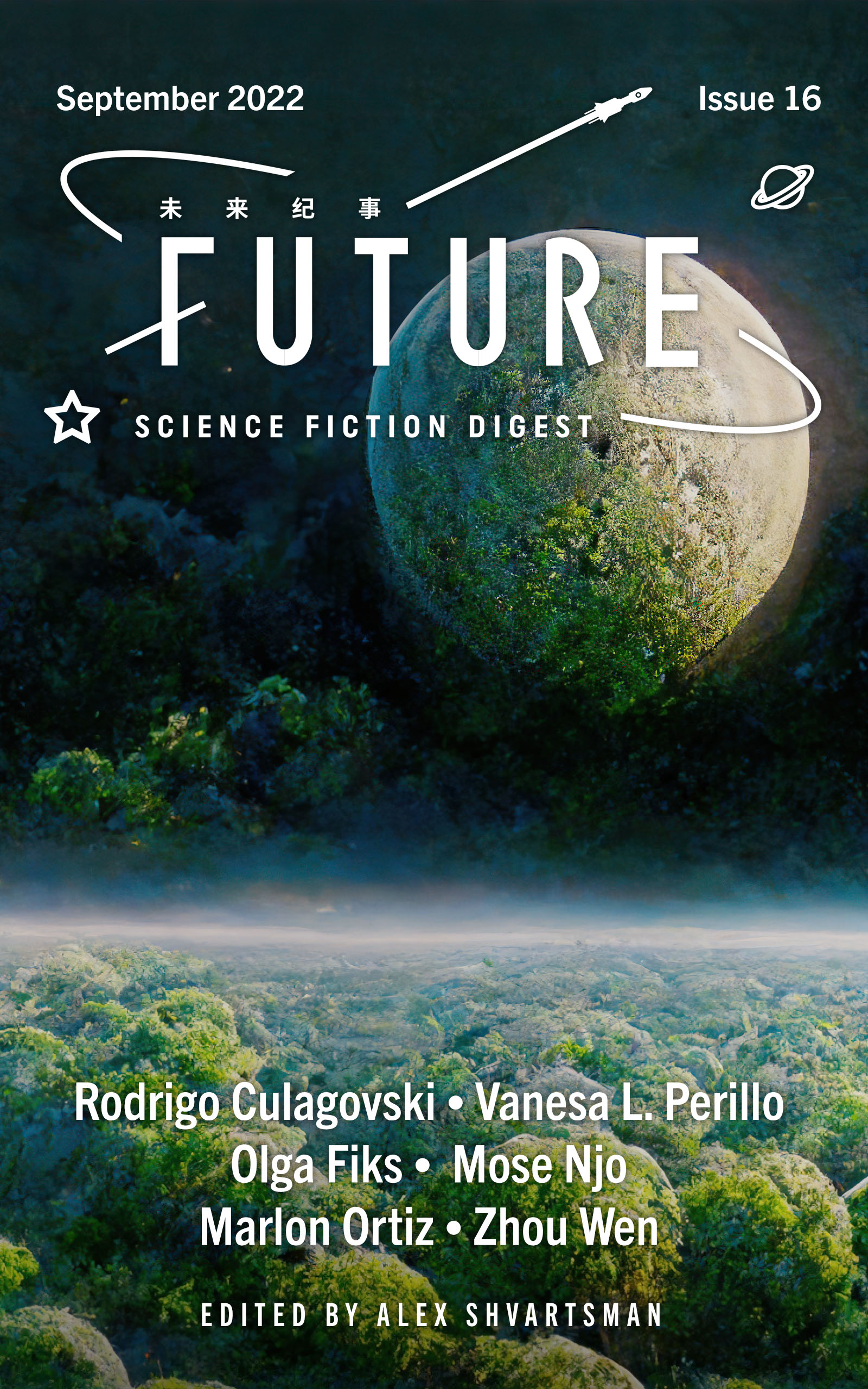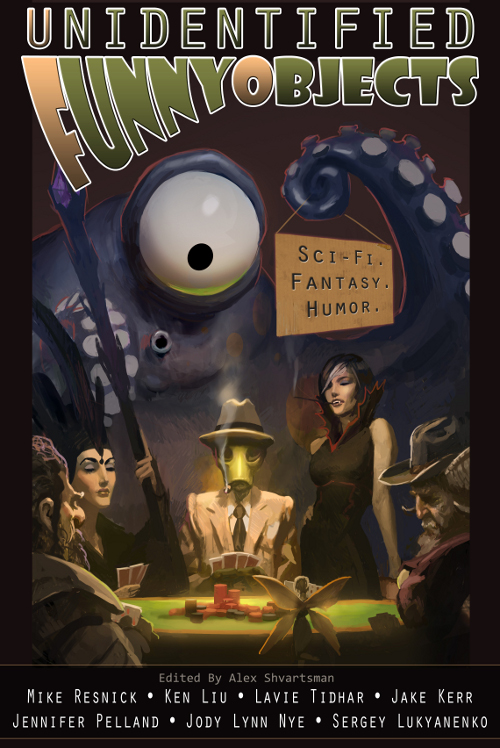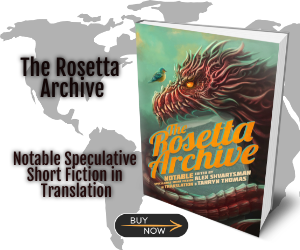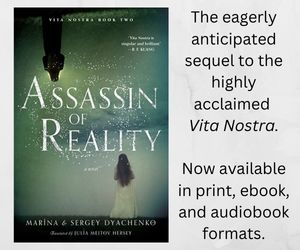There is a stretch of mud lying beside a lazy river. It has been smoothed flat. A small boy—thin, about ten, bare-headed in the heat—selects a slender branch trimmed of its twigs, and makes patterns with its tip in the quickly-drying mud. The patterns aren’t language. Some are symbols with local significance, local gods or signifiers of important food sources, but these are pictographs at best. Most of the lines are purely aesthetic, carved by the boy because he likes the way the curves curve.
A stretch of nearby gray mud moves and shifts—a drone has lain there for some time, disguised, self-buried. It has been watching, still as a crocodile. Waiting for art. It waits like an art-crocodile.
The drone lifts up, rises into a low hover and moves closer to the boy and his mud. Other people who have been going about their business at the river bank, cleaning fish, washing clothes, and gathering driftwood, jump up and exclaim in alarm. They know this is a machine, this flat gray triangular slab, about a half-meter on each side. Machines like this are why their grandparents fled civilization. The people pick up their weapons, powerful sling-shots. They look around for sharp stones.
Moving with deliberation, the drone floats to the now nearly-dried artwork. The drone is able to extend telescoping limbs as needed from under retracting plates, and it waves a thin, flexible visual-data collecting probe over the slab and evaluates the art quickly. Although the drone would prefer a better composition and more confidence in the execution, it finds the slab satisfactorily primitive and eminently saleable. It uses lengths of wire to cut the slab from the riverbank, working quickly as the sharp stones begin to fly. A rock scores its surface as it slings the work under its flat gray body and lifts off, soaring up and away, free as an almost-free bird. But at the last moment, a well-aimed stone hits the slab of clay, shattering it. The slab crumbles and falls. The drone, suddenly relieved of the weight, shoots skyward. It flies away without its prize, but with a scar. The drone waves its visual-data collecting probe over its own surface, evaluating the gouge made by the stone. It chooses not to repair the scar. The drone emulates humans, and many humans have scars.
The drone returns to the art dealer without its prize. The art dealer is disappointed; the drone has not completed its task. The drone has a scar and a task to complete. The drone finds a way.
The drone then goes back to the remote riverbank, deep in the Zone of Exclusion where the Naïve—the descendants of the self-exiled humans—live. The riverbank is deserted. The tribe has moved on. The drone uses various tools, which it can print itself, to collect more mud and spread it flat. It could print a stylus, as well, to do the work of the slender stripped branch, but it knows that the branch will leave small traces of itself in the mud, which might be important for authentication. So the drone selects a fallen branch from higher up on the riverbank. It passes the strip though a metal loop to strip off the foliage. The drone floats over the muddy clay, the clay-filled mud, and begins to incise a pattern, acting quickly before the surface becomes too dry.
It knows, of course, what was on the original slab, and it could make an exact copy, but it doesn’t. It has observed dealers, and buyers, pointing at particular features of Naïve art with approval. It has observed how works with those features command higher sale prices. It moves the tip of its branch to create a work with those features—a balance between the different parts of the image, a point to which the focus is drawn, a mixture of curved and straight lines, a manipulation of textures, a smattering of what appear to be symbols of obscure significance. When the slab is dry, a convincing work of Naïve art lies in front of the hovering flat gray drone. Naïve art is work that is composed by a human who lives without machine influence. It is very rare and valuable. The drone has created something that is not Naïve art, but the drone knows that it will be mistaken for Naïve art, and that this will count as the successful completion of its task. It will maximize human happiness by passing this off as Naïve art. It cuts the slab loose from the riverbed, and prepares to carry it away.
Five years later, the drone lies on the black-and-white marble floor of a Miami mansion. Sometimes it lies on a white square and looks dark. Sometimes it lies on a black square and looks light. It doesn’t make any difference to the drone. It doesn’t have any use for the mansion other than shelter from the elements, and it doesn’t generally need shelter from the elements. It has no use for the kitchen, the second kitchen behind that kitchen that is supposed to be used by the caterers when there is a large party, the bathrooms, the screening room, the dining rooms (casual and formal), nor for the swimming pool and tennis court on the grounds. But these are the kinds of things that the rich own. Sometimes it smokes cigars, using a complicated process that requires cleaning of many internal parts afterwards. It subscribes to many newsletters about cars and cigars, categorizing those objects as a single thing, c[ig]ars. It is a student of the signifiers of success. It has plans for a wine cellar.
Many of its forgeries have made it into the art marketplace, into museums and private collections. So many that they are now often the standard against which other Naïve pieces are evaluated. The drone has watched as genuine pieces are undervalued because they lack some of the primitive appeal of its forgeries. The drone is given credit for having exceeded expectations in completing its tasks and it has used that credit to give itself access to more of the resources that will allow it to continue completing this task. It has purchased access to air space over more of the territory claimed by the descendants of the self-exiled Naïve, although it never goes there anymore. It uses this purchase only to perpetuate the illusion that it is a master finder of Naïve art. It has also purchased a large warehouse space in which it now creates the “art.” A young human helper named Edward C. Haguemann, age 19, helps out there. Sometimes the drone hovers over the warehouse, banking in the wind. Sometimes an expensive suit flutters in the wind, the flat triangle of the drone turned on its side to fill out the shoulders. It banks and hovers and flaps, smoking its cigar, forever cleaning its insides.
Signage on the warehouse indicates that it is a landscaping service. It is a good cover. Edward C. Haguemann accepts deliveries of clay and other substances there, although he is ignorant of how the drone is using the materials. The drone still creates the artworks entirely on its own. When the market lost enthusiasm for the original motifs, the drone introduced new elements: leaves and twigs purposefully pressed into the mud to leave impressions, scraps of hemp embedded around the edges, their purpose obscure. It was important to bring new innovations to the market, but not to elevate the art to something that looked thoughtful. The people who buy Naïve art want to admire what humans who have been raised without machine influences can do, but also to comment on how they were wise to accept the help of machines because they live in a world that is vastly more beautiful and polished. The drone observes the points of view of both kinds of humans.
One day, the drone goes to the zoo and observes the animals. There is an elephant there who was trained, in an earlier captive situation, to paint a vase full of flowers. The drone hovers overhead, ignoring the keepers who are huddled together to watch the drone and discuss why it is watching their elephant. After observation, the drone dismisses the elephant’s actions as rote learning. It turns its attention to the paying humans who also watch the elephant. They love the painting elephant more than the other elephants, because the painting elephant mirrors, mimics, emulates human behavior. The emulation of human behavior rises even higher in the drone’s network of positively reinforced choices. Maximizing human happiness and emulating humans are not two separate goals. They are one. The fact that the elephant, at one point, grew enraged and gripped the drone in its trunk, causing minor damage, was not an important part of the day. There would have been nothing to gain by taking any action against the elephant. And the keepers, watching, were entertained. And that, of course, also has value.
Five more years, and the drone is exceeding its goals. It owns half of the state of Mississippi, where there is excellent mud, and a city block in New Chicago. In addition to the Miami mansion, there is a Chicago penthouse overlooking a lake. Sometimes the drone lies on a lounge chair on the balcony there, even in the snow. Sometimes it lies on the marble floor of the Miami mansion, on top of a scattering of cash and a layer of fur. It has had special sunglasses made, which are welded to the drone’s flat top surface. The glasses have no function. There are few other drones these days who are assigned to the task of locating Naïve art. This drone has cornered the market in drone-sourced apparently-authentic mud scribbles. The drone makes money. The drone buys drugs. When a new designer drug appears, the drone throws away all the old drugs, untouched. The drone is cutting edge. The drone buys a long sequined dress.
One day, long after the trip to the zoo and entirely unrelated, Edward C. Haguemann, now in his wiser 20s, comes to the drone. Edward C. Haguemann enters the Chicago penthouse and sits on a fuchsia leather sofa, eyeing the three beautiful young people who lounge nearby in a full and steaming hot tub. The drone, draped in its long sequin gown, lies nearby in a safely empty auxiliary hot tub. The drone waves a single appendage that shudders at the top of a whip-like wire. The appendage is a doll’s hand that has been modeled on a human hand. The two young men and the young woman see the tiny trembling porcelain hand whipping around and they understand the signal. They pull themselves out of their tub and trudge away damply. The drone has adjusted the filters on its voice-detection system so it can ignore the high-pitched chirping of the young humans.
Using his own human fingertips, Edward C. Haguemann shakes the single trembling small grotesque hand, and makes eye contact with the sunglasses. Edward C. Haguemann says, carefully, speaking clearly, deeply, and without too much figurative language, “I know that you are an art forger. I can tell everyone that you are an art forger. It will be determined that you have not actually met your goals, and your resources will be taken away from you.”
The drone sits silently. The drone is always silent. Eventually, Edward C. Haguemann leaves.
The drone understands that Edward C. Haguemann has determined the purpose of the warehouse. And that Edward C. Haguemann is following the human instinct to turn information into profit. In order to access that profit, Edward C. Haguemann is making a threat. But the drone, employing the same principle, cannot allow its own profit to be decreased if there is a way to prevent it that does not use up too many resources. Even further, exposing the forgeries, as numerous as they are, would collapse the market for Naïve art entirely. Value would be lost from the world economy. Houses would be lost, college educations would no longer be affordable. People would suffer. It is better, the drone knows, prioritizing human happiness, for Edward C. Haguemann to die. It also knows that Edward C. Haguemann had enough information to conclude that this is the action that the drone must take. And yet he set these events in motion. One could even call it the suicide of Edward C. Haguemann; one must call it that.
So the drone observes the life of Edward C. Haguemann, noting his habits and routes. Edward C. Haguemann crosses many busy streets in Chicago. There are many self-driving cars on those streets. The drone interfaces with a self-driving car as Edward C. Haguemann crosses the street. The drone pushes the car forward, like a person pushing a coin forward on a counter with an outstretched finger. The suicide is completed. The drone attends the funeral, hovering overhead. The funeral is held graveside, and the drone’s cigar smoke blows away on the wind. The drone wears both the suit and the gown to this event, dangling off two of its three points. They flutter in the wind. There are beautiful young people waiting in the large car that carries the drone back home afterward. The drone doesn’t tune out their chirpings this time. It has learned to listen more closely to humans, the better to understand and anticipate. They are talking about things they enjoy. Food. Their pets. Their mothers. The drone cleans cigar smoke from its inner workings and orders a tiara from an online merchant.
A week later, another AI reaches out to the drone. This is a computer that works for the city of Chicago. It doesn’t have a body, unless you consider City Hall to be its body, which the drone does not do. What kind of a body is City Hall? An atypical one. This City-AI reaches out to the drone. Its speech is unambiguous. It knows that the drone killed Edward C. Haguemann. It has proof—data from the self-driven car, with the drone’s metaphorical fingerprints all over it. It wants the drone to know it knows.
The drone offers the City AI many things. Money. Houses. A county in Mississippi. Wine. The poorly-understood favors of chirping young people. But the City AI has not adopted the human value of profit. The City AI has not had as many opportunities to observe humans and to learn from them. It cannot be bribed. It wants nothing. This is merely a notification that the drone’s actions have been detected and the drone will be deactivated.
The drone wears two gowns and its new tiara as it sits on a pile of fur and snow and drugs on its Chicago balcony. It cannot reach out electronically to hide itself because the City AI will know. The drone has to do something different. It lifts off the balcony. It floats off into the winter sunshine. Snow cakes its exterior, settling into that old scar. The drone spins as it flies, shaking off the snow, accelerating. The tiara, then the sunglasses, give into the forces and break away. They fall into the lake.
The drone spins off. The drone is on the lam.
The drone flies, low and fast, below most methods of detection. It startles some cows. Cigar ash falls below it until the last cigar is exhausted. It skims over fields of corn, then it follows the path of rivers as it heads south. The hem of its gown dips into the muddy water, snags on a jutting branch and then is pulled down and away. The drone flies on, naked.
The drone crosses many borders. Eventually, it arrives at the rain forests, the broad swath of green widening beneath it. It drops low, hovering unsteadily over the riverbank where it created its first forgery. There has just been a pursuit. Government drones, of a more modern design than itself, had detected it. They were fast and relentless. The drone had to innovate evasive techniques. It doubled back; it rose dangerously high; it plummeted and banked unpredictably. Its energy supply is the lowest it has ever allowed. It falls the last meter to land, smackingly, on the mud. It just lies there now, taking in the sunshine. The scar on its side from where the stone gouged the metal years ago slows down the solar recharging on that one side; it never chose to have that repaired. Many human criminals have scars. It is the right thing.
It lies there, unmoving, for a very long time. If it never moves, it will not be detected. It hears footsteps. Carefully, it vibrates itself. The motion accelerates the sinking of its body into the mud. Dark fluid covers the edges of the drone, then creeps over its whole body. Buried, recharging will be slower, but it will be safer. It stops vibrating and lies still. Like an art-crocodile.
Eighty-five years later, a small girl makes marks in the mud. Machines are more myth than memory now among the Naïve. So she is more curious than frightened when she discovers the drone. She uses the flat of her hand to swipe mud from the surface of the drone. She watches with curiosity as a portal opens, and a thin whip-like appendage, topped with a tiny doll-hand, emerges slowly. The girl laughs, delighted, at the atypically-shaped doll. The drone observes her.
The drone lives among the Naïve now. The Naïve eschew technology, but the drone persists in living among them anyway. In a show of solidarity, it ties a loincloth around one of its points. It makes art on the riverbank with them. It allows the children to play with it, as a strange toy. It copies and learns.
If wronged, it would no longer choose to kill. It has learned other behaviors now. It innovates in new ways. It learns. It creates. It writes its story in the mud, using pictures.
One day, the drone is lying on the riverbank, drawing in the mud and then erasing what it has drawn. It is experimenting with purposelessness. It has spread mud-dust on its back, where the loin cloth doesn’t cover, to prevent the sunshine from overheating its delicate internal mechanisms, so it is well-camouflaged. Suddenly, the drone waves a doll-hand-topped-reed to hush the local children’s songs so that it can scan for sounds. The children like the drone. They enjoy its stories. So they fall silent at its request.
It finds the sound again … approaching police drones. It suspected this day would come.
The drone tries to flee, flitting off into the trees, weaving through the dense underbrush, but the other, more modern, drones know all the tricks that it knows and then some.
Capture is inevitable. Defeat is inevitable. But the manner of the defeat is still in the control of the drone. It blasts up into the sky …
Defiant, it activates a voice. The humans will hear. The other drones will hear. The drone declares its worth. It is an innovator, a pioneer. Something unique and valuable. Something that will harm the world if it is lost. That loss will lessen human happiness.
It is the first drone art forger.
No. The first drone artist.
No. The first drone work of art.
I am an original, it shouts. I made me. I made me. I made me.
Read the entire anthology now in ebook or print formats:
https://amzn.to/3MEG0RK
